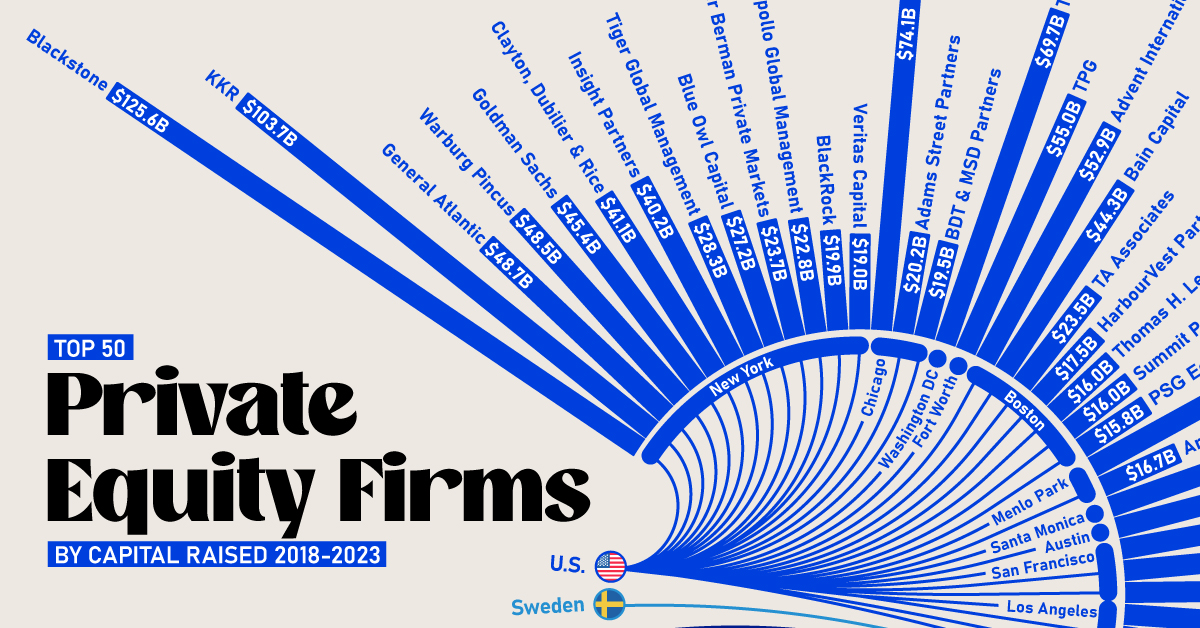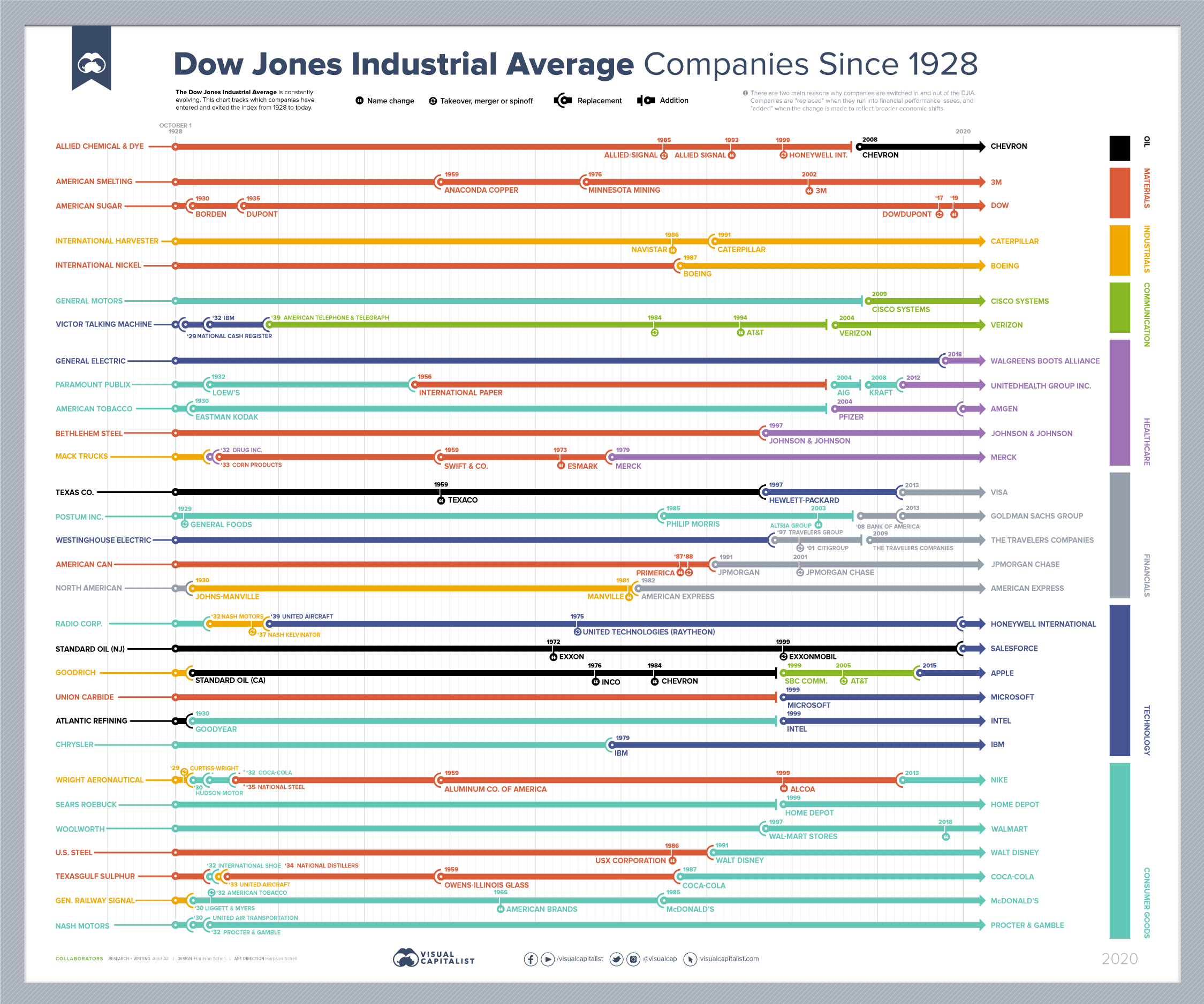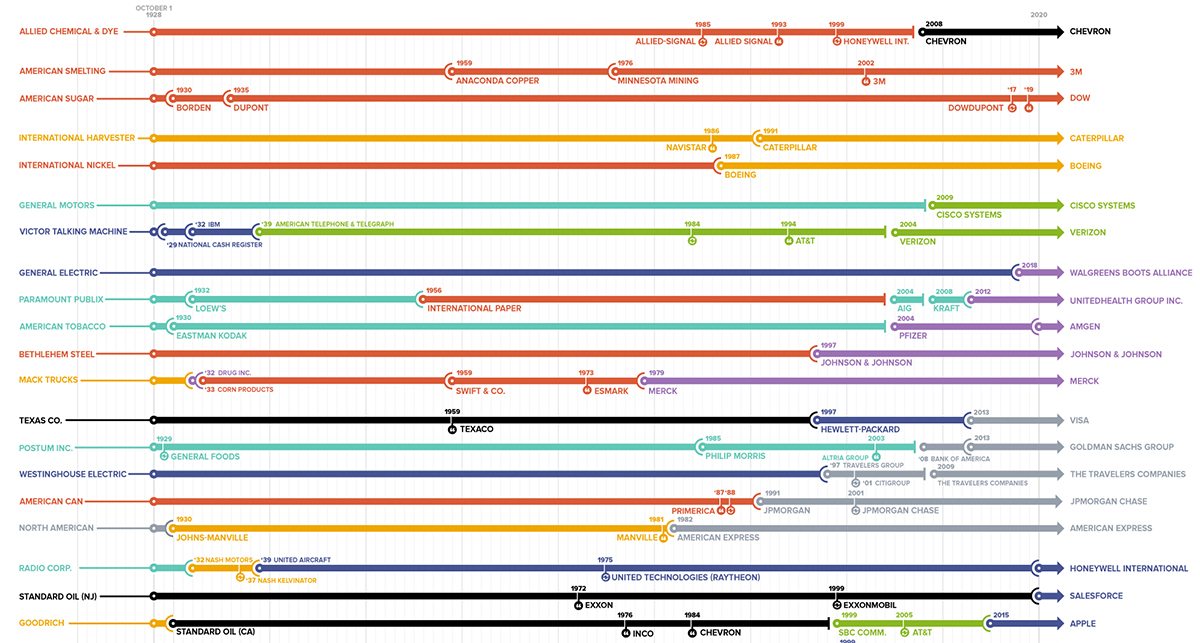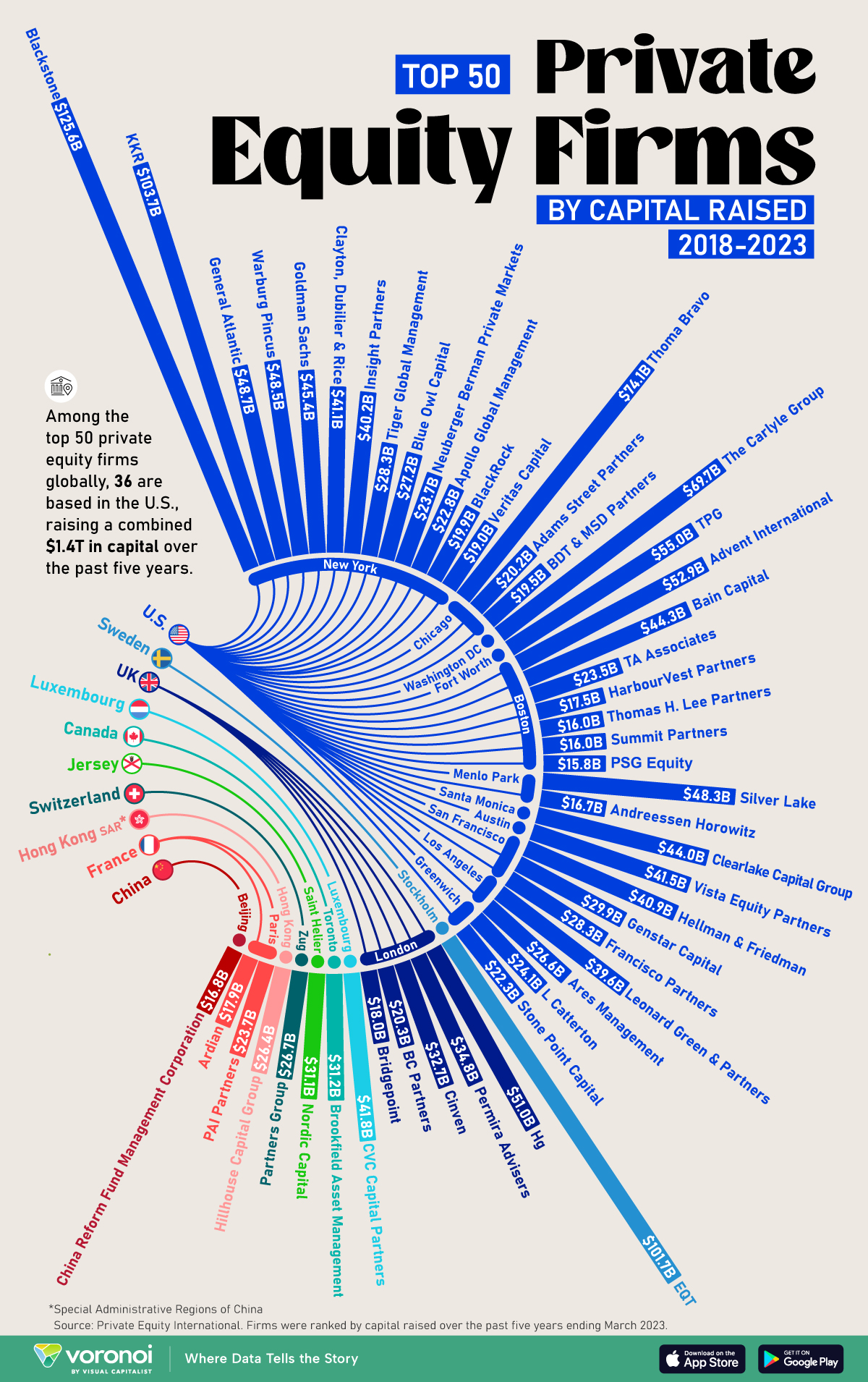Finance
Every Company In and Out of the Dow Jones Industrial Average Since 1928
View the full-size version of this infographic.
Every Company In and Out Of The Dow Since 1928
View the high resolution of this infographic by clicking here.
The Dow Jones Industrial Average (DJIA) is reported on daily by every major finance and media platform—a testament to its importance and relevance in global financial markets.
The market benchmark has a rich history embedded alongside America’s rise as a global superpower in the 20th century, and the inflows and outflows of companies on the 30 stock index coincide with broader secular trends. For example, the delisting of many industrial stocks over time encapsulates America’s transition towards a service-based economy. Meanwhile, the addition of tech companies in the last few decades paints a similar picture of change.
Today’s infographic looks at Dow data spanning over nine decades, all the way back to the tail end of the Roaring Twenties.
Crank Up The Volatility
An increasingly competitive and accelerating business landscape results in greater churn for stock market indices.
In fact, in the 92 years of activity visualized for the DJIA, there were 93 changes in its composition. This is not surprising, as the average duration of a company’s tenure on American indices has been trending down for decades—that said, 63% of Dow changes occurred in the second half of the 92 year sample period.
The current iteration of the DJIA includes some long-serving constituents, with the average length of companies in the index sitting at 20 years. General Electric was the last standing member of the original group from 1928, but in 2018, they were replaced by Walgreens.
2020 has also brought with it some fresh faces, including three changes so far. They include Salesforce for ExxonMobil, Amgen for Pfizer, and Honeywell International for United Technologies. Here’s a full list of the current companies in the index:
| Company | Market Cap (B) | TTM Revenue (B) | YTD Stock Performance |
|---|---|---|---|
| American Express | $81.1 | $34.3 | -21.0% |
| Amgen | $149.8 | $23.1 | 3.0% |
| Apple | $1996 | $273.9 | 55.0% |
| Boeing | $94.6 | $66.6 | -49.5% |
| Caterpillar | $81.2 | $43.6 | -0.2% |
| Cisco Systems | $167.2 | $49.3 | -18.5% |
| Chevron | $134.8 | $115.0 | -40.3% |
| Goldman Sachs Group | $69.3 | $18.2 | -14.4% |
| Home Depot | $299.2 | $119.3 | 24.6% |
| Honeywell International | $116.6 | $34.5 | -7.1% |
| IBM | $109.1 | $74.3 | -9.8% |
| Intel | $221.5 | $79.0 | -14.5% |
| Johnson & Johnson | $392.2 | $80.5 | 0.8% |
| Coca-Cola | $212.2 | $34.3 | -11.6% |
| JPMorgan Chase | $295.4 | $76.3 | -31.6% |
| McDonald's | $170.9 | $19.1 | 10.7% |
| 3M | $93 | $31.4 | -9.4% |
| Merck & Co. | $209.9 | $47.2 | -10.0% |
| Microsoft | $1596.3 | $143.0 | 31.4% |
| Nike | $196.4 | $37.3 | 24.7% |
| P&G | $347.3 | $71.0 | 9.9% |
| The Travelers Companies | $27.6 | $28.6 | -21.6% |
| United Health Group Inc. | $297.4 | $195.1 | 3.5% |
| Salesforce | $195.8 | $19.4 | 52.2% |
| Verizon | $255.3 | $129.7 | -3.5% |
| Visa | $428.8 | $22.9 | 6.1% |
| Walgreens Boots Alliance | $31.3 | $138.7 | -40.0% |
| Walmart | $398.9 | $542.0 | 15.4% |
| Walt Disney | $225.6 | $69.8 | -13.3% |
| Dow | $35.4 | $3.1 | -14.9% |
| Average | $297.67 | $88.5 | -3.1% |
Although all the stocks in the DJIA are intended to be in line with broader economic trends, the similarities end there. For some DJIA stocks, 2020 has brought growth and opportunity—for others, quite the opposite.
YTD stock price performances range vastly from a high of 55% to a low of -49%. Perhaps it serves as no surprise that the best performing companies serve in the tech space like Apple, Microsoft, and Salesforce, while the worst performing are the likes of Boeing and Chevron.
A Sign of the Times
The three changes in 2020 can best be described as modernizing the Dow.
The delistings include businesses in industries such as Aerospace & Defense and Big Pharma. But the most monumental exit? ExxonMobil, which was once the biggest company by market capitalization in America.
Their fall from grace best symbolizes the state and direction the world is headed towards.
Finance
Ranked: The World’s 50 Largest Private Equity Firms
In this graphic, we show the largest private equity firms in the world—from titan Blackstone to China’s leading alternative funds.

The World’s 50 Largest Private Equity Firms
This was originally posted on our Voronoi app. Download the app for free on iOS or Android and discover incredible data-driven charts from a variety of trusted sources.
In 2023, private equity firms controlled $8.2 trillion in assets globally according to McKinsey & Company, a figure that has rapidly expanded since the industry first emerged 40 years ago.
As large investors such as pension funds and insurance companies increasingly look to private markets, these alternative asset managers have seen their assets grow by more than twofold in the last five years.
This graphic shows the top 50 private equity firms worldwide, based on data from Private Equity International (PEI).
The Top 50 Private Equity Firms
To determine the rankings, private equity firms were defined as those that raise capital with the purpose of directly investing in businesses, covering diversified private equity, venture capital, growth equity, buyouts, along with turnaround or control-oriented distressed investment capital.
The ranking does not include funds of funds, private investment in public equity (PIPE), or funds that follow a secondaries, real estate, infrastructure, hedge fund, debt or mezzanine strategies.
Below, we show the 50 biggest private equity companies around the world, measured by the scale of capital raised over the five-year period ending March 31, 2023:
| Ranking | Fund Manager | City | Capital Raised |
|---|---|---|---|
| 1 | Blackstone | New York | $125.6B |
| 2 | KKR | New York | $103.7B |
| 3 | EQT | Stockholm | $101.7B |
| 4 | Thoma Bravo | Chicago | $74.1B |
| 5 | The Carlyle Group | Washington DC | $69.7B |
| 6 | TPG | Fort Worth | $55.0B |
| 7 | Advent International | Boston | $52.9B |
| 8 | Hg | London | $51.0B |
| 9 | General Atlantic | New York | $48.7B |
| 10 | Warburg Pincus | New York | $48.5B |
| 11 | Silver Lake | Menlo Park | $48.3B |
| 12 | Goldman Sachs | New York | $45.4B |
| 13 | Bain Capital | Boston | $44.3B |
| 14 | Clearlake Capital Group | Santa Monica | $44.0B |
| 15 | CVC Capital Partners | Luxembourg | $41.8B |
| 16 | Vista Equity Partners | Austin | $41.5B |
| 17 | Clayton, Dubilier & Rice | New York | $41.1B |
| 18 | Hellman & Friedman | San Francisco | $40.9B |
| 19 | Insight Partners | New York | $40.2B |
| 20 | Leonard Green & Partners | Los Angeles | $39.6B |
| 21 | Permira Advisers | London | $34.8B |
| 22 | Cinven | London | $32.7B |
| 23 | Brookfield Asset Management | Toronto | $31.2B |
| 24 | Nordic Capital | Saint Helier | $31.1B |
| 25 | Genstar Capital | San Francisco | $29.9B |
| 26 | Francisco Partners | San Francisco | $28.3B |
| 27 | Tiger Global Management | New York | $28.3B |
| 28 | Blue Owl Capital | New York | $27.2B |
| 29 | Partners Group | Zug | $26.7B |
| 30 | Ares Management | Los Angeles | $26.6B |
| 31 | Hillhouse Capital Group | Singapore | $26.4B |
| 32 | L Catterton | Greenwich | $24.1B |
| 33 | Neuberger Berman Private Markets | New York | $23.7B |
| 34 | PAI Partners | Paris | $23.7B |
| 35 | TA Associates | Boston | $23.5B |
| 36 | Apollo Global Management | New York | $22.8B |
| 37 | Stone Point Capital | Greenwich | $22.3B |
| 38 | BC Partners | London | $20.3B |
| 39 | Adams Street Partners | Chicago | $20.2B |
| 40 | BlackRock | New York | $19.9B |
| 41 | BDT & MSD Partners | Chicago | $19.5B |
| 42 | Veritas Capital | New York | $19.0B |
| 43 | Bridgepoint | London | $18.0B |
| 44 | Ardian | Paris | $17.9B |
| 45 | HarbourVest Partners | Boston | $17.5B |
| 46 | China Reform Fund Management Corporation | Beijing | $16.8B |
| 47 | Andreessen Horowitz | Menlo Park | $16.7B |
| 48 | Thomas H. Lee Partners | Boston | $16.0B |
| 49 | Summit Partners | Boston | $16.0B |
| 50 | PSG Equity | Boston | $15.8B |
Private equity titan Blackstone is the top in the United States and the world, raising $125.6 billion in capital from 2018 to 2023.
Headquartered in New York, Blackstone’s total assets under management stood at $991 billion as of the first quarter of 2023, and have since surpassed $1 trillion this year. For perspective, this is comparable to the GDP of the Netherlands.
Following next in line are KKR and Sweden’s EQT, each raising over $100 billion. In fact, this was the first time three firms achieved this $100 billion equity-raise milestone in PEI’s ranking over a five-year period. This was particularly notable given a challenging fundraising landscape amid higher borrowing costs and lagging dealmaking activity.
North American Firms Dominate Private Equity
As we can see, the vast majority of the biggest private equity firms are based in America, accounting for 36 of the top 50 firms globally. North American PE firms made up $1.34 trillion (72%) of the $1.85 trillion raised by the top 50 firms in the ranking.
Falling in second by a wide margin is Europe, with nine firms making up $179 billion (9.7%) of the total funds raised. Many of Europe’s largest private equity firms are based in London, England, with the most prominent asset managers in the city being Hg and Permira Advisors.
Across Asia, the top alternative investment firm was Singapore-based Hillhouse Capital Group, which launched in 2005. The firm has backed several internet companies spanning from Tencent, the largest publicly-traded company in China, to Baidu, but has faced increasing setbacks amid regulatory crackdowns and a sluggish Chinese stock market.
-

 Personal Finance1 week ago
Personal Finance1 week agoVisualizing the Tax Burden of Every U.S. State
-

 Misc6 days ago
Misc6 days agoVisualized: Aircraft Carriers by Country
-

 Culture6 days ago
Culture6 days agoHow Popular Snack Brand Logos Have Changed
-

 Mining1 week ago
Mining1 week agoVisualizing Copper Production by Country in 2023
-

 Misc1 week ago
Misc1 week agoCharted: How Americans Feel About Federal Government Agencies
-

 Healthcare1 week ago
Healthcare1 week agoWhich Countries Have the Highest Infant Mortality Rates?
-

 Demographics1 week ago
Demographics1 week agoMapped: U.S. Immigrants by Region
-

 Maps1 week ago
Maps1 week agoMapped: Southeast Asia’s GDP Per Capita, by Country

















